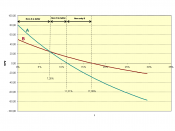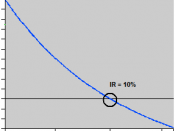Norwich Tool's Lathe Investment DecisionAs time goes by in a machine shop, tools such as lathes tend to breakdown and wear out. Such is the case at Norwich Tools. Mario Jackson, financial analyst, now has the task at hand to prepare the proper analytical comparisons to facilitate the decision-making process. Mr. Jackson has prepared the following estimates of the initial investment and incremental cash inflows associated with each lathe shown in Table 1. Also included in this report are assessments of payback period, net present value (NPV), and internal rate of return (IRR) which will complete the comparisons by expressing the risks involved. A recommendation on which lathe would be more beneficial to Norwich Tools concludes this analysis.
Table 1(Gitman, 2006, p.398)Payback Period MethodGitman (2006) defines the payback period as "the amount of time required for the firm to recover its initial investment in a project, as calculated from cash inflows" (p.
354, para. 3). Table 2 and Table 3 show how to arrive at the payback period.
For Lathe A in Table 2, the calculations show the payback period is 5 years; calculations on financial calculator show the period to be 4.04 years.
Table 2Lathe AYear 0Year 1Year 2Year 3Year 4Year 5Cash Flow-660000128000182000166000168000450000Cumulated CF-532000-350000-184000-16000434000For Lathe B in Table 3, the calculations show the payback period is 4 years; calculations on financial calculator show the period to be 3.65 years.
Table 3Lathe BYear 0Year 1Year 2Year 3Year 4Year 5Cash Flow-360,00088,000120,00096,00086,000207,000Cumulated CF-272000-152000-5600030000237000Using these results, and the company's criteria that any investment must have a payback period of no longer than 4 years, the Lathe B option would be chosen as the acceptable project. However, payback period ignores any benefits that occur after the payback period, so it does not measure total incomes. This method also ignores the time...


